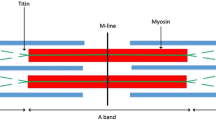Summary and Conclusions
-
1.
The nature of response of frog’s stomach muscle to nervous stimulation is described. The contraction is similar to that produced by acetylcholine and potassium, and is not of the same type as that produced by alternating current, suggesting that acetylcholine is liberated during nervous stimulation of frog’s stomach. Excitation by nervous stimulation appears to involve the potassium ion.
-
2.
Nervous stimulation also produces a contraction similar to that produced by alternating current, thus suggesting that electrical transmission precedes chemical. It is suggested that chemical transmission imparts tome properties to the effects of electrical transmission.
-
3.
On nervous stimulation, circular fibres of the stomach give the second kind of contraction, and longitudinal the first kind or tonic contraction. It is probable that the function of the longitudinal fibres is to maintain a tonic pressure on its contents and prevent the sagging of the stomach, and that of the circular fibres is to mix the contents by rhythmic contractions, as well as to exert a tonic pressure.
Similar content being viewed by others
References
Gessel,et al. Am. Jour. Physiol,141. 312; quoted from C. J. Wiggers,Physiology in Health and Disease, London, 1944.
McDowell, R. J. S.Handbook of Physiology and Biochemistry, London, 1944, p. 593.
Narayana, B., and Singh, I.Proc. Ind. Acad. Sci., 1944,20, 192.
Singh, I.J. Physiol., 1938a,92, 62.
—, 1938b,94, 322.
—, 1938c,91, 398.
— 1939,96, 367.
—Ind. Jour. Med. Res., 1942,30, 629.
—Proe. Ind. Acad. Sci., 1944a,20, 209.
—, 1944b,20, 195.
—, 1944c,19, 91.
-Curr. Sci., 1944d, October.
—Proc. Ind. Acad. Sci., 1945,22, 123.
—, 1946,23, 58.
— and Mrs. Singh, I. —, 1946,23, 301.
Author information
Authors and Affiliations
Rights and permissions
About this article
Cite this article
Singh, I., Singh, S.I. The mode of action of nerves on unstriated muscle. Proc. Indian Acad. Sci. 25, 163–172 (1947). https://doi.org/10.1007/BF03049681
Received:
Issue Date:
DOI: https://doi.org/10.1007/BF03049681




